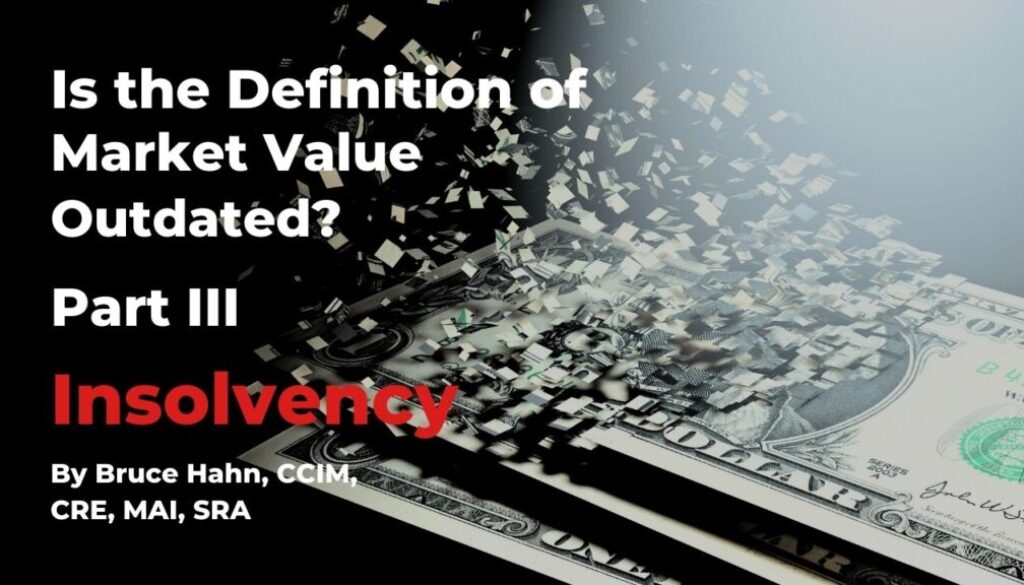Editor’s Note: This is Part 3 of Bruce Hahn’s series on Is the Definition of Market Value Outdated?
In Part One and Part Two we asked why the current definition of market value has been around without change for so long? We focused on item 4 in the current definition of market value which says:
“payment is made in terms of cash in U. S. dollars or in terms of financial arrangements comparable thereto”
LEVERAGE
The artificially low interest rates of the last few years do not represent financial arrangements that are equivalent to CASH in US dollars. These artificially low interest rates distorted the analysis of risk vs reward. The market did not factor in the impacts that rapidly rising interest rates would have on real estate, and many other asset classes, which are becoming evident now.
LIQUIDITY
Real estate is a capital-intensive asset that requires liquidity since most buyers utilize leverage in their purchase transaction. Rapidly rising interest rates in the last 12 months have impacted many banks and other lenders in an adverse way. The rising rates have repriced assets (bonds and other securities) in such a way that lenders are now more restrictive in their credit terms. Credit is no longer as readily available as it has been for several years. If it is available, it now comes with a higher cost in the form of a higher interest rate.
SOLVENCY
The rapid changes in the cost of Leverage and availability of Liquidity have created another problem which many banks now face – Solvency. Although the banking liquidity crisis appears to have paused, it does not address the problem that remains. Despite getting loans to provide the immediate liquidity they need; many banks are still insolvent. Losses on bond investments mean that the value of their holdings may no longer be sufficient to cover their liabilities.
In addition to interest rate (Leverage) risks, isn’t real estate also susceptible to the impacts of both Liquidity and Solvency. When lenders suffer losses, or fear potential losses, they tighten their lending standards, or lend less money. When it is more difficult to get a loan than it has been in the last few years, the lack of liquidity frequently has an adverse impact on real estate market values and on marketability. Everyone wanted to lend you money in the last few years, but that is not always the case – often times it can be much more challenging to get a loan. Real estate markets that are heavily dependent on mortgage financing will be adversely impacted when there is less Liquidity available.
So, Solvency is also a problem for real estate. Buyers that got large loans (80% or more) at sub 3% interest rates in early 2021 paid near peak prices for real estate. With the cost of debt service now increased, these properties have both liquidity and solvency issues. Most buyers will not qualify to pay the much higher costs of necessary debt service with loans to finance the same prices paid by 2021 buyers. Nor should they want to even if they qualify! In some instances, 2021 buyers (with 80% or greater LTV at purchase) may also be insolvent – they may have a loan balance that now exceeds the current market value of their real estate. Insolvency with real estate leads to REOs and short sales.
So why is the definition of market value so hopelessly out of date? Clearly risks with Leverage matter. So do Liquidity and Solvency – so why don’t appraisers consider the impacts of Leverage, Liquidity, and Solvency as it can relate to real estate market value? Clearly they matter! And it seems highly likely that this will once again be illustrated by the real estate market very soon!

April 5, 2023 @ 7:48 am
What is the point of this post? What is the benchmark the author wants to set market value at if not US Cash? The CCP Yen or some other currency? What is the ideal price point? How should leverage, liquidity, and solvency be adjusted? Adjustments for cash equivalency are only used when financing is not market typical, so is this an argument for adjusting the entire market?
I have been through 50 years of market ups and downs, and this argument has not changed: price is a snapshot in time versus the worth of real estate over the life of the investment.
This is why the scope of work and the definition of market value matter in the assignment itself.
April 5, 2023 @ 8:53 am
The hindsight here is 20/20. Interest rates had been low for years and were the prevailing means of financing home purchases. Are we supposed to have prognosticated what rates were going to do? If we could do that we’d all be Wall St billionaires. The biggest problem with the current definition of value is that our clients and the users of appraisals never understood that it is a set of hypothetical conditions. How many buyers & sellers are well informed or well advised? Supply and demand are not and have not been in equilibrium for some time in many markets. Yes, we probably do need a revised definition of market value but more importantly we need the users of appraisals to understand what it means.
May 13, 2023 @ 7:03 pm
It would seem the users of appraisals are perfectly content with the current definition of market value. I’m not so sure it’s ours to change.